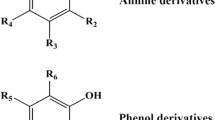Abstract
In this study, the toxicity of 49 mixed halogenated benzenes to Dicrateria zhanjiangensis was determined and the partition coefficient of these mixtures was described by using the C18-EmporeTM disks/water partition coefficient (K mix). According to these data, a simple K mix-based QSAR model was successfully used to correlate the toxicity of the mixed halogenated benzenes to D. zhanjiangensis.


Similar content being viewed by others
References
Cao CZ, Li ZL (1997) Estimation and prediction of partition coefficient for some substituted benzene. China Environ Sci 17(6):501–503. doi:10.3321/j.issn:1000-6923.1997.06.006
Delorenzo ME, Serrano L (2003) Individual and mixture toxicity of three pesticides: atrazine, chlorpyrifos, and chlorothalonil to the marine phytoplankton species Dunaliella tertiolecta. J Environ Sci Health B38:529–538. doi:10.1081/PFC-120023511
Gatidou G, Thomaidis NS (2007) Evaluation of single and joint toxic effects of two antifouling biocides, their main metabolites and copper using phytoplankton bioassays. Aquat Toxicol 85:184–191. doi:10.1016/j.aquatox.2007.09.002
Hsieh SH, Tsai KP, Chen CY (2006) The combined toxic effects of nonpolar narcotic chemicals to Pseudokirchneriella subcapitata. Water Res 40:1957–1964. doi:10.1016/j.watres.2006.03.026
Kőnemann H (1981) Quantitative structure-activity relationships in fish toxicity studies. Part 1: relationship for 50 industrial pollutants. Toxicology 19:209–221. doi:10.1016/0300-483X(81)90130-X
Lin ZF, Yu HX, Wei DB, Wang GH, Feng JF, Wang LS (2002) Prediction of mixture toxicity with its total hydrophobicity. Chemosphere 46:305–310. doi:10.1016/S0045-6535(01)00083-2
Lin ZF, Du JW, Yin KD, Wang LS, Yu HX (2004) Mechanism of concentration addition toxicity: they are different for nonpolar narcotic chemicals, polar narcotic chemicals and reactive chemicals. Chemosphere 54:1691–1701. doi:10.1016/j.chemosphere.2003.09.031
Morris L (1977) An introduction to the algae. Hutchinson & Co Ltd, London
Nicklin J, Graeme-Cook K, Paget T, Killington R (1999) Instant notes in microbiology. Bios Scientific Publishers Limited, Beijing, China
Organization for Economic Cooperation and Development (2002) OECD guideline for testing of chemicals: freshwater alga and cyanobacteria, growth inhibition test. Draft Revised Guideline 201. Paris: OECD
Preston S, Coad N, Townend J, Killham K, Paton GI (2000) Biosensing the acute toxicity or metal interactions: are they additive, synergistic, or antagonistic? Environ Toxicol Chem 19:775–780. doi:10.1897/1551-5028(2000)019<0775:BTATOM>2.3.CO;2
Sun CB, Wang XH, Bi HQ (2005) Commercial culture of marine one-celled algae. Fish Sci 24:39–40. doi:cnki:ISSN:1003-1111.0.2005-08-013
Verhaar HJM, Leeuwen CJV, Hermens JLM (1992) Classifying environmental pollutants. 1: Structure-activity relationships for prediction of aquatic toxicity. Chemosphere 25(4):471–491. doi:10.1016/0045-6535(92)90280-5
Verhaar HJM, Busser FJM, Hermens JLM (1995) A surrogate parameter for the baseline toxicity content of contaminated water. Environ Sci Technol 29(3):726–734. doi:10.1021/es00003a021
Acknowledgments
This work is sponsored by the National Natural Science Foundation of P.R.C.#: 20677063, the National Natural Science Graveness Foundation of P.R.C.#: 40490264, the Science and Technology Foundation of Guangzhou City, P.R.C.#: 2007J1-C0241, the opening Foundation of Key Laboratory of Marine Environmental Science, Xiamen University, Xiamen, P.R.C.#: MEL0504, and the opening Foundation of Key Laboratory of Yangtze River Water Environment, Tongji University, Shanghai, P.R.C.#: YRWEF07004.
Author information
Authors and Affiliations
Corresponding authors
Rights and permissions
About this article
Cite this article
Zeng, M., Lin, Z., Yin, D. et al. QSAR for Predicting Joint Toxicity of Halogenated Benzenes to Dicrateria zhanjiangensis . Bull Environ Contam Toxicol 81, 525–530 (2008). https://doi.org/10.1007/s00128-008-9570-y
Received:
Accepted:
Published:
Issue Date:
DOI: https://doi.org/10.1007/s00128-008-9570-y




